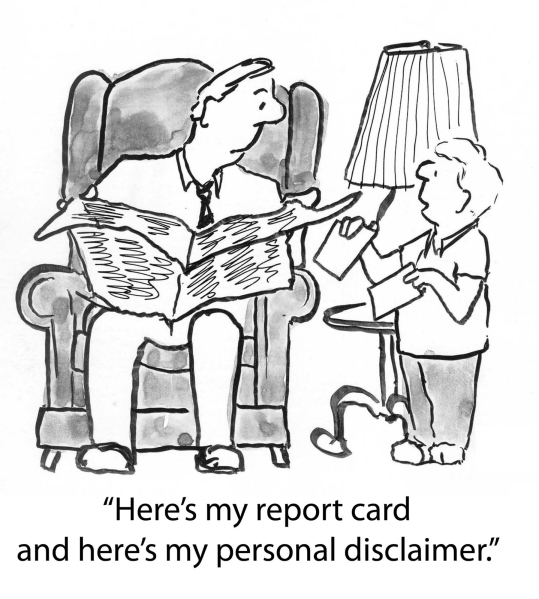It seems of all the things we change in education, the unit of a grade (A-F) seems to be like a concrete block that has its own kryptonite type powers averse to change. As a result, as we learn more about how students learn, how we motivate students, and how best to measure student achievement, we are stuck tied to a grading system that is the proverbial square peg in the round hole that is progress in education.
All of us, parents, students, and educators alike have wondered at one time or another what is meant by the grade we received on the report card. Wondering whether an A in one class is the same as an A in another, or why we got a B for 88% of the total points in one class, but in another that is an A-? And, what if one teacher has 1000 points in the grade book and another only has 100 – does that matter in the final grade? Classroom teachers have traditionally had a great deal of independence and leeway in determining what gets counted as an academic grade and what doesn’t. This is good and bad in that professionals have professional judgement and we all know (and can probably describe in detail) the times when a grade really didn’t fit – or at least didn’t tell the whole story so professional judgement in the assignment of the grade was essential, fair, and reasonable.
In other cases, getting 5 extra credit points for bringing in a box of kleenex or knowing everyone’s name in class is not a measurement of content learning and not really essential, fair, or reasonable (on a side note…I was TOTALLY guilty of these point additions as a classroom teacher).
So the conversation started to bubble at North and the question was asked, what is best practice in grading? Over the past four years as principal, I have been able to see the staff grapple with this question, do research, and implement practices that help to truly identify for students, parents, and teachers exactly what a grade means.
So where does that leave us? With the following grading purpose and some changes in our junior high grading practices across both buildings this year.
Our purpose is to use research-based best practices to provide students and families with consistent feedback and information on their academic progress.
Our grading process shifts from the traditional approach of adding total points and dividing out percentages in three ways:
Focus on Formative and Summative Assessments
Formative assessments are assignments that are assigned to evaluate students’ learning while it’s happening — during an instructional unit — giving students ongoing feedback of their progress, and opportunity for improvement. Examples of formative assessments may include quizzes, assignments, or teacher observations. Some of these assignments may come from in class work, and some may be homework. Students get descriptive feedback on progress on the assessments recorded in the formative category. These are progress checks and account for no more than 20% of the weight of the final grade.
Summative assessments are used evaluate student learning and achievement at the end of an instructional unit — to assess the knowledge acquired. Examples of summative assessments may include midterm exams, a final project, a written paper, a performance, or final exams. These account for no less than 80% of the weight of the final grade.
Practice – you may see a third category recording how students are doing on practice assignments. These may be practice homework assignments, class participation, or other indicators of behavior or work habits. These are important to communicate both to students and parents as we know these habits are a crucial part of building student skills that will endure through high school and beyond. In fact, we are explicitly teaching approaches to learning such as organization and communication and progress in those areas may be recorded in this category. This category doesn’t get recorded as a weight in the final reported grade.
PAUSE BUTTON!
I will admit the first time I read about the research that supports this shift, I was SO concerned about my students that worry about tests to the point of detriment. However, Summative Assessments are more than just tests. Projects, presentations, labs, and tests are all summative assessment tasks. What I learned, however, is that when you give kids a chance to practice, check on progress a few times (formative assessment), and then do some sort of final assessment (which may or may not be a test), there is less of a stress because they know it! The content on the summative should not be a surprise and the teacher will have given feedback on progress along the way. My message to my worriers is…you’ve got this, now show me what you know!
ALSO…there is no excuse to not do homework. Whether the homework is practice or a formative/summative assessment, it is crucial for the learning progress.
*PLUS…here is the segue to the next shift in thinking about grading at Hopkins junior highs…
Summative Re-take Opportunities
To ensure that teachers record a true account of what a student knows, and to allow students to own their own learning through accountability, students are allowed to retake summative assessments. The student must take responsibility for initiating and following the retake procedures with the teacher – the process for retakes is detailed in the class syllabus. Only one retake per summative assessment is allowed. There are some times, however, where it is not feasible to retake a summative assessment either because of the time it is taken (like end-of-semester exams) or the format of the assessment (like a demonstration, or a performance). If the summative assessment won’t be able to be retaken, the teacher will notify the students prior to taking the exam. Finally, the teacher may require that students do additional practice or complete all missing/incomplete practice assignments or formative assessments before a retake can be given.
*The final shift is our way of trying to make the square peg fit in the round hole (reference to the beginning of this post if you can remember that far back already!)
Elimination of the “zero” in grading
In our traditional percentage based system, a grade is demarcated every 10 percent or so (90-100 = A, 80-89 = B and so on…) all except for an F which gets 50% of the scale dedicated to itself. Although and F is a pretty important indicator of achievement, there really aren’t 5 different levels of failure. So, in this sense, a score of zero is seldom an accurate description of a student’s achievement.
This means the bottom of our grading scale (an F) is 50 percent to 59 percent. That’s the floor. Anything below that level is an F but won’t require students to recover five levels of F to get to the next level of achievement.
Non-completion of work, or work refusal, will be communicated to parents/guardians through the Infinite Campus Parent Portal comments, rather than through letter grades. The use of a zero score in grading will be eliminated.
(Helpful hint…use the computer version of parent portal to check for missing assignments. If you see a score recorded at 50%, the comments will tell you if it is missing. On the app, you have to click to see the comments, on the desktop version you can see comments on the same screen so one less click.)
PAUSE BUTTON!
Again, when I read the research, I thought of how weird it sounds to record a score of 2 out of 10 as 50%. It’s weird. No denying it. But, this is the only way we can work around the outdated system of the 100% scale. An F, is an F, is an F. If you think about it this way, 2/10 is an F…which is recorded in the grade book as an F – at the lowest level F we’ve got…50%.
Phew…I know this is a lot for a blog post, but it’s even more for an email!
I am proud to be a principal in a district that follows what the research says is best for students and, in practice, really gets at measuring and communicating what is learned. Ask questions, and by all means communicate with your children’s teachers as we navigate some of these shifts this year.
For more information and research on grading, there are a few authors to check out- here are a few places to look…to start, anyway – I have lots of resources if you’re interested!
Ken O’Connor has several books and articles – this is more of a handbook but has some great research and background –
- Connor, K. (2011). A repair kit for grading: 15 fixes for broken grades(2nd ed.). Boston: Pearson.
Thomas Guskey is also a prolific writer and researcher on grading practices – below is an article and a book citation.
- Guskey, T., & Bailey, J. (2001). Developing grading and reporting systems for student learning. Thousand Oaks, Calif.: Corwin Press.



